The damage you will be looking at with a statue will differ depending on whether your sculpture is:
1/ A Foundry Bronze metal statue,
2/ or Bronze Resin statue (also known as a cold-cast bronze statue),
Sometimes a sculpture may suffer damage during the course of its life. This is much more likely to occur with a Bronze Resin, than with a Foundry Bronze metal sculpture.
On the other hand, Bronze Resins are easier to repair, and the repair can be cheaper. The good news for either material is that serious repairs use repair methods identical or almost identical to those used to put the statue together in the first place – so your statue should look as good as new afterwards. We have seen 40-year-old Bronze Resins brought in from the garden and then repaired to look brand new, which is fairly miraculous as outdoor decorations and furniture go.
The artist who made the statue should be in a position to help you. If the sculpture is older and you have had it for some time, they will likely assist you with advice. In our case we try to provide the best bronze aftercare that we can, and for if your bronze statue needs more serious repair we will arrange for your statue to be fixed at cost, (either by us or locally in your country).
If the statue is damaged when being shipped to you, take several well-lit photos of the whole statue, of the area of damage, and the packaging. Keep all the pieces, wrapped everything with care and place it back in the box. An artist should always sort out transportation damage for you – through return and refund (you’ll need the box here), or by replacing it, or by arranging a specialist to make the repair at the artist’s cost where these first two options are not practical.
How can a Bronze Resin statue be damaged, and how can it be fixed?
Sculptures, like cars or pieces of furniture, can be well made or they can be made poorly. Some damage you might see could result from a poorly made statue, some might be caused by a hidden defect missed in a quality control process, while some damage comes from normal wear and tear, and some comes from accidental damage.
Damage caused by a statue being poorly made
To the right is a picture of a counterfeit Bronze Resin sculpture made in China, and copied from the photos on this website. This poorly made fake, sold on a broke in the post, and the lady contacted us to ask for a replacement.
Underneath is the real thing – the Running Saluki. We had to explain to a understandably upset lady that we only make this sculpture in Foundry Bronze metal, and that we were unable to illegitimate websites from copy-pasting images from our website to sell knock-offs.
Diagnosing damage caused by a hidden defect
The quality control process has to be thorough to pick up possible issues, but some may not be obvious until later in the life of the statue:
BRONZE RESIN STATUES ONLY:
– Damage appears like a sharp sided patch of lighter coloured bronze: The top, darker coloured surface of the bronze is gone and the normal rewaxing using Black Bison ‘Medium Oak’ doesn’t colour the lighter bronze area the same darker colour as the surrounding area.
Cause is normally a small air bubble inside the bronze powder and resin mix layer.
Minor defect. Purchase a small tin of Liberon Iron Paste. This paste has a much, much stronger stain in it that is almost black. On a dry day, apply paste thinly and evenly with a very small paint brush until you can no longer see the lighter area. Leave to harden for 24 hours. Polish with a cloth.
– Damage appears like a sharp sided larger hole: You may see a white or grey substance inside, or you may see a black void (ie if the hole goes through to the cavity inside the sculpture).
Cause is normally a medium air bubble in the deeper resin layer. The surface of the entire sculpture is gone over with a pin or sharp tool during the making process, to detect these before the statue is completed. If one is missed, it can break in the future leaving a bubble shape, or a hole.
Medium defect. Photograph and send to artist. Depending on seriousness, may require specialist to repair, or might be resolvable with advice and a small repair kit.
– Damage sounds like sloshing water: Generally only applicable to large outdoor Bronze Resin statues that have been outside for some time. When the sculpture is moved suddenly, sloshing water can be heard inside the statue.
Cause is normally a small hole (or perhaps a hard to spot larger hole) on the top of the statue.
Medium defect. Try to identify the hole. Photograph and send to artist. Depending on seriousness, may require a specialist to repair, or might be resolvable with advice and a small repair kit.
– Damage looks like a flaky or soft surface: Possibly the revealed surface is white or grey in colour. When you apply wax to this surface, the wax is gone in a few weeks.
Resin has not cured (dried) properly.
Significant defect. Contact the Artist, this requires a specialist to repair.
FOUNDRY BRONZE STATUES ONLY:
– Damage looks like the statue has broken in two parts: The break is bright gold and possibly jagged.
Invisible defect in a welding point, or a small air bubble in the metal. Almost no hidden defects in a Foundry Bronze metal will ever cause a problem, because the material is so tough. However, if major pressure is put on bronze metal, for example if badly mishandled by a courier, a thin piece of the metal like a leg can break.
Significant defect. Contact the Artist, this requires a specialist to repair.
Diagnosing damage caused by accidental damage
If you broke your bronze statue by accident, it is worth speaking to the artist to see what can be done. Or your bronze statue may have arrived broken in the post, in which case the artist should take responsibility for replacing it, refunding it, or where agreed, to have it fixed by a local specialist to a standard as good as new.
BRONZE RESIN STATUES ONLY:
– Damage appears like a small chip, small crack, or a worn looking area: A small chip on a bronze resin may look like a missing piece of texture. A small crack looks like a hairline dark area crossing through a few different textures. A worn looking area looks much lighter than the surrounding bronze colour, normally beige-looking or white-looking.
Cause is normally a minor issue with handling the statue. A small chip might be caused by a small knock, or the placing of the sculpture on a hard surface with slightly too much force. A small crack is likely caused by mild over stress of a delicate area during movement. A worn-looking area is likely caused by excessive rubbing of a material against the sculpture, or an unprotected area of the sculpture rubbing as the statue moves – both most common during transportation.
Minor defect. Purchase a small tin of Liberon Iron Paste. This paste has a much, much stronger stain in it that is almost black. On a dry day, apply paste thinly and evenly with a very small paint brush until you can no longer see the lighter area. Leave to harden for 24 hours. Polish with a cloth.
– Damage appears like a larger chip, larger crack, or a missing piece or pieces of the sculpture: This kind of damage looks obvious, even from a small distance away.
Cause is normally a significant issue with handling the statue. A hard bump, the knocking over, fall or damage by a tool or machine.
Medium or Major defect.
This kind of damage is most often repaired by a specialist. Try to locate any missing pieces, large and small. Wrap them protectively and place them in a clearly labelled bag. Take photos of the damage and send them to the sculptor.
If you wish to attempt to fix this kind of damage at home, gluing the broken pieces together at will not fix this kind of break invisibly. However, with direction from the artist and a small repair kit, a fix with a very strong two part glue is possible for lesser damage.
Simplistically, this involves:
– A small repair kit, including bronze powder, a cloth, a ‘stiff’ two-part apoxy glue, an application tool like a small metal spatula, your own rotary tool, such as a dremel, with a pointed bit, (and for larger chips you have the broken piece for; a piece of copper wire, and your own drill and thin drill bit)
– (If cracked) cleaning the crack of wax, and using a rotary drill tool like a dremel to create a small fissure into which you will place the repair mix.
– (If chipped and you have the piece) sand the broken edges of the chipped piece, and the broken edges of the sculpture using a rotary drill tool like a dremel. Drill a small hole in the exposed resin on both pieces, aiming to align the holes when the two pieces are held together. Cut a piece of copper wire to length, the wire should sit inside the two holes when the broken piece is held on the sculpture.
– (If chipped and the piece is gone) sand the broken edges of the sculpture using a rotary drill tool like a dremel)
– Mix the glue part of the two part glue with a large amount of bronze powder at a ratio of 2:5. This looks like adding two thirds the size of the glue part in bronze powder. Then add and mix in a small amount of the catalyst part of the two-part glue. Visually this looks like adding a pea sized amount of catalyst to a golf-ball sized amount of glue-and-bronze-mix.
– (If cracked) use the spatula to push glue mix into the crack. Once the crack is filled, remove excess glue from the surface of the statue using a cloth. Lastly, carefully use the spatula to dab a little texture into the glue mix, copying texture on the surface of the sculpture in the nearby area.
– (If chipped and you have the piece) Use the spatula to push glue mix into the two holes and thinly coat the broken parts. Place the copper wire in one hole and press the pieces together so the copper wire enters the other hole. Use the spatula to push glue mix into the crack. Once the crack is filled, remove excess glue from the surface of the statue using a cloth. Lastly, carefully use the spatula to dab a little texture into the glue mix, copying texture on the surface of the sculpture in the nearby area.
– (If chipped and the piece is gone) Use the spatula to shape the glue mix into an approximation of the missing piece. As the glue-mix hardens, continue to shape it and texture it, copying the surrounding area of the sculpture. Once dry, use a piece of sand paper to gently remove unwanted texture. We don’t recommend trying this unless the piece is not visible, or you are very confident in your modelling skills!
– In all cases, purchase a small tin of Liberon Iron Paste. This paste has a much, much stronger stain in it that is almost black. On a dry day, apply paste thinly and evenly with a very small paint brush until you can no longer see the fixed area. Leave to harden for 24 hours. Polish with a cloth. Re-wax over the top using a medium oak stain wax, leave to dry and then polish again.
Before you begin, select your wax.
If you have a coloured bronze, or if your sculpture is bronze colour and you like the way it is looking, then choose a natural or clear furniture wax. (We recommend Black Bison Wax – Natural).
If your sculpture is a bronze colour, and the colour is looking a little faded, or you have not waxed it for two or three years, choose a medium brown furniture wax. (We recommend Black Bison – Medium Oak).
Then prepare your cleaning area.
Some wax has a stain in it, which can damage furnishings. We recommend you clean your sculpture on a piece of cardboard if practical.
Open your furniture wax tin and allow the wax to soften in the sunshine. This will aid easy application later.
(Note – if you leave the lid on the pot and the tin gets very hot, the lid may pop off and cause a mess. )
Clean the surface of your statue
First, use the bristles of a paint brush to remove cobwebs and debris from deeply textured areas.
Do not use abrasive brushes, nylon pads or wire wool pads to clean your sculpture.
Second, use a nylon brush to remove stubborn bird poo marks. A double headed nylon brush is provided in our outdoor cleaning set.
If you bought a bronze coloured Foundry Bronze metal sculpture and it has turned green in places (called verdigris), but you do not like the colour, then rub the green area vigorously with your nylon brush until most of the verdigris has come off in a dusty film. Select a wax with a stain, rather than a clear wax to deal with verdigris residue.
Clean your statue with water and towel it off
Third, clean your sculpture using water and a soft brush or wet cloth.
Remember, do not use cleaning chemicals on your sculpture. Because bronze is coloured chemically (and using heat), cleaning chemicals on your sculpture can change the colour.
Fourth, dry the sculpture with an old towel to prevent streaks.
If you do not dry the sculpture, dirt will reappear on the artwork once the water it is suspended in evaporates.
Wax your statue to protect it for another year
Fifth, apply a thin layer of wax from the tin with a paint-brush. Careful: wax can stain! Avoid nice clothing and carpets!
Apply the wax with a stippling motion (a dabbing motion) to help the wax reach deeper detail.
There is no need to wax beneath the underside of the sculpture, which is in contact with the ground.
As you apply the wax, use the paint brush to push wax from areas where you have applied it thickly, to areas you have not reached yet. Applying the wax too thickly will cause the buffing stage to take longer and waste wax.
If you are waxing your sculpture indoors, or if the wax has not got soft in the tin, then you can use a hair dryer to speed the process.
Heat an area of surface of the sculpture with hair dryer until the wax turns more liquid when applied to the heated surface. This will help you move the wax around the surface of the sculpture more easily.
Important Warning: using a hair dryer speeds the waxing process, but if you are cleaning a Bronze Resin, you must be very careful not to overheat the resin by holding the heat on one area for a long time. Very high temperatures can cause cracking – so you may warm the area until the wax turns more liquid, but then must redirect the hair dryer.
Buff the wax off your statue to give it a nice shine!
Check that you have applied wax to the whole surface of the sculpture, (except the underside in contact with the ground).
Then leave the sculpture for 20 minutes, to allow the wax to cool.
If it is a hot day, it may not fully cool in all areas – but you can still proceed to the next stage after 20 minutes.
Buff the sculpture using a soft brush (like a boot brush).
If you have purchased a Bronze Resin, place your thumb over the end of the wooden handle, to avoid knocking the statue with the wood. Please take care, and remember that detailing can be fragile!
It is very important to thoroughly buff your sculpture, because residual wax can cause accidental staining of hands or clothes on a warm day.
Perform a final buff using a lint-free cloth. This will bring your sculpture up to an appealing shine.
Pick free any loose threads with fingers, or carefully with tweezers.
Your sculpture should now be well protected for another year.
We are really happy to hear from you if you have any questions about maintaining your bronze statue!
What happens when you find damage to your sculpture that looks like it requires repair?
If your Bronze Resin or Foundry Bronze metal statue has sustained a deep scratch or a small area of impact damage that is still visible even after a re-wax, consider our page: ‘Repairing your bronze statue / Scratches, Cracks and Accidental Damage’ <UNDER CONSTRUCTION>.
Can bronze corrode? The simple answer is no.
Neither Foundry Bronze metal or Bronze Resin corrodes in normal conditions.
There is a rare condition that can be suffered by a Foundry Bronze metal statue is chloride corrosion, known as ‘bronze disease‘. This sounds scarier than it is, because it is almost wholly limited to historic artifacts taken from the seabed and from shipwrecks.
For the purpose of this page on maintaining bronze sculpture, the best advice we can give is to avoid placing a foundry bronze statue in the sea or in a swimming pool.
If you do wish to place your sculpture there, consider a Bronze Resin, or even a non-cuprous (non-copper-based) resin like Stone Resin. Also, stone or concrete may also be preferable materials for in-pool or salt water statues. Excessive exposure to salt water or pool water by very near proximity (like beside the diving board, or a pool fountain) is also a good reason to use a different sculpture material. However, if you simply own a property on the coast or you have a pool somewhere in the garden, the waxing process will adequately protect your Foundry Bronze metal sculpture.
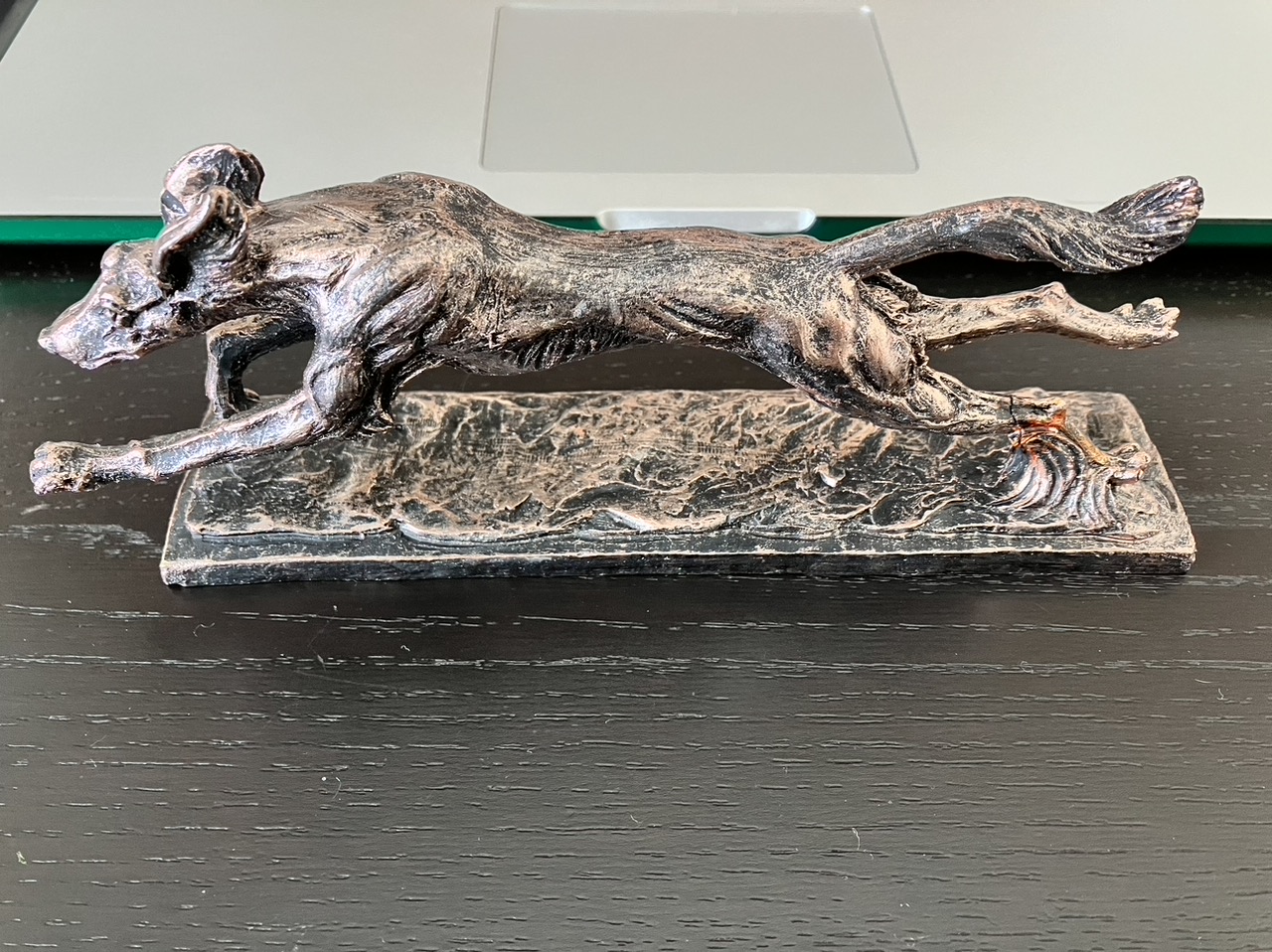
(Above) A poorly made fake Bronze Resin statue with a broken leg.

(Above) The real thing, which is only available in Foundry Bronze metal so the ankle is strong enough to support the one-legged running pose.
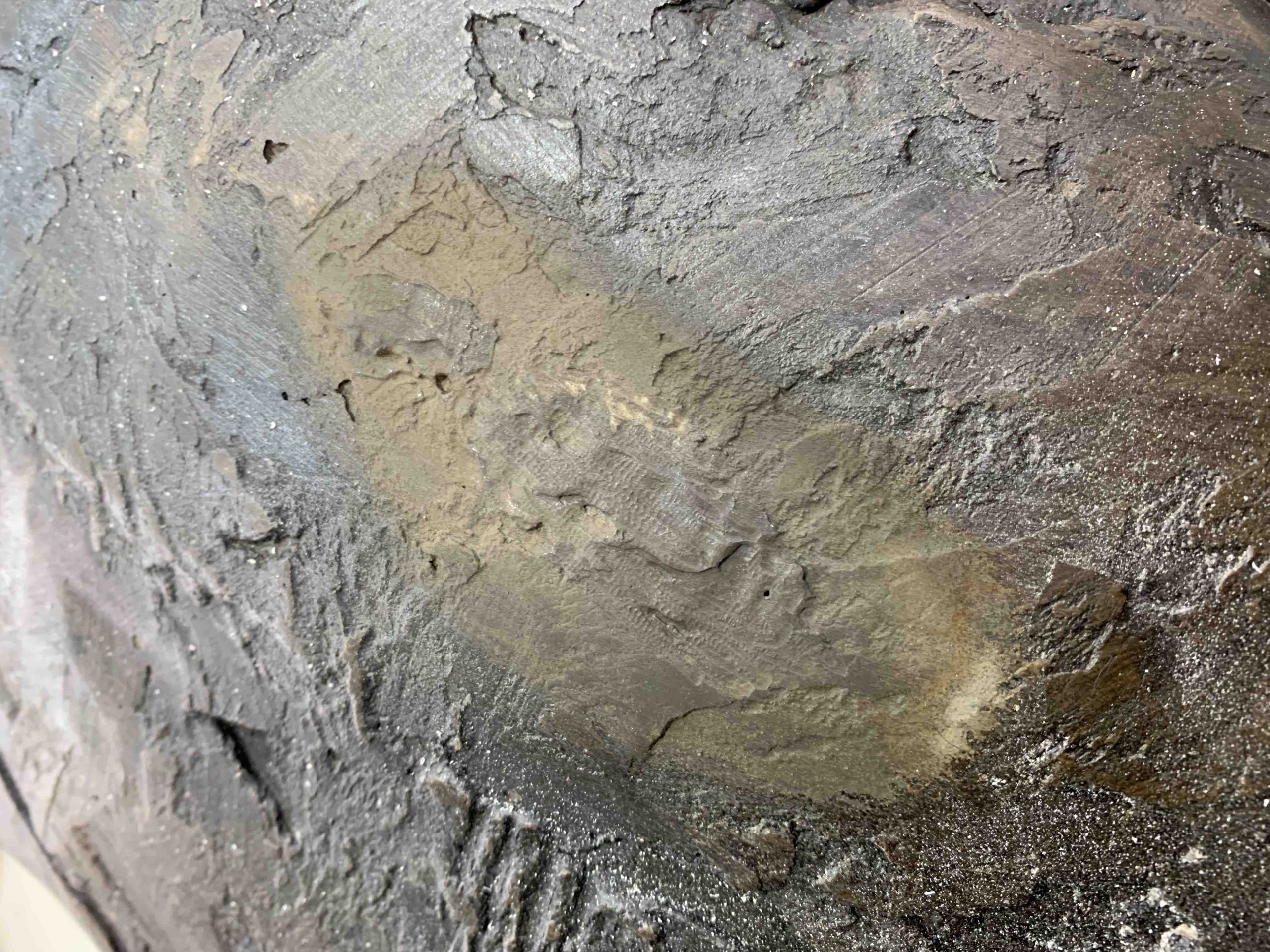
(Above) Repair of a medium defect – a hidden air bubble has opened and been repaired. This repair has not been shaped or rewaxed yet. You can see the lighter colour of unwaxed bronze resin, and in the middle, the slightly darker bronze of the partly done repair.
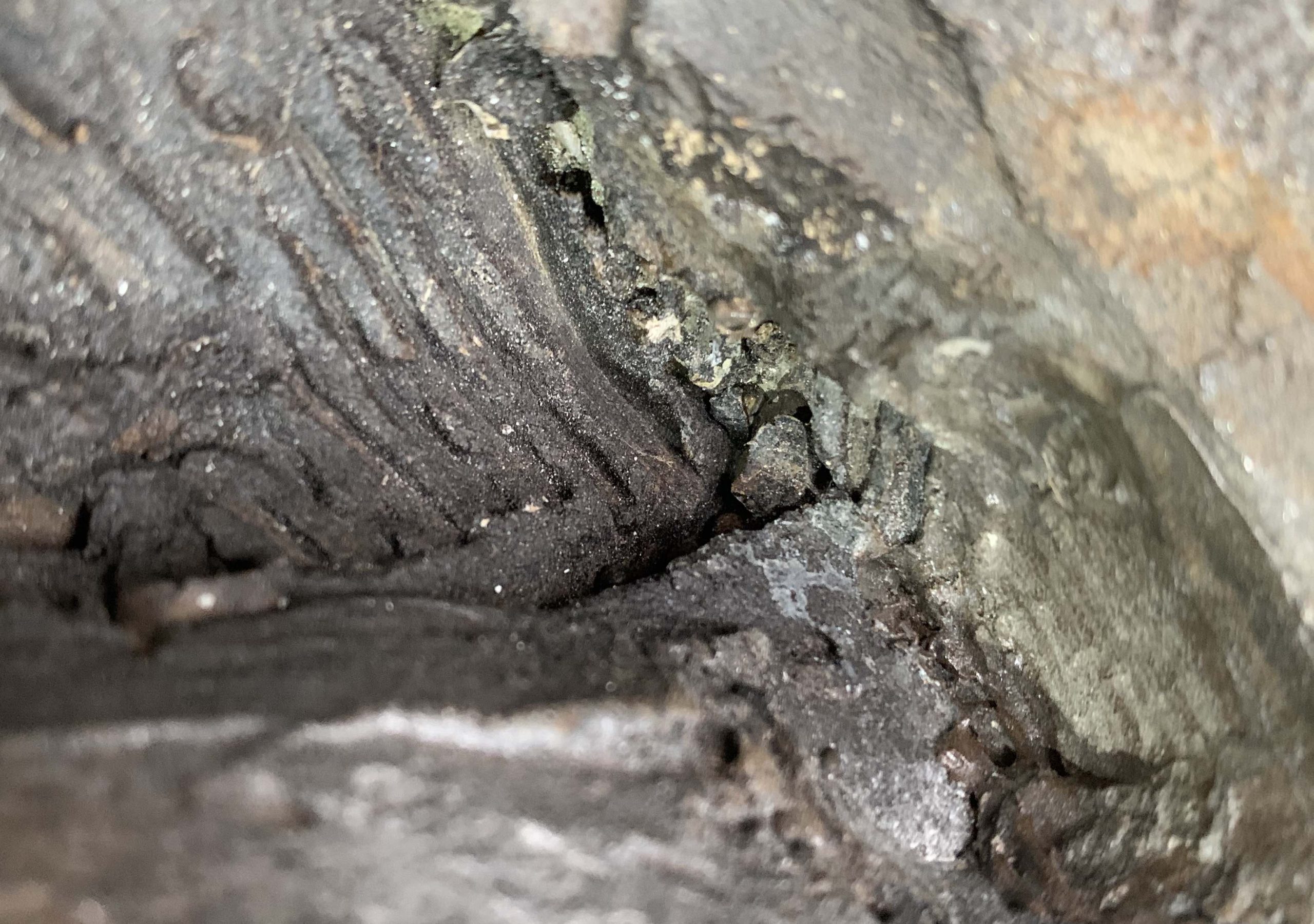
(Above) Look carefully at the centre of this image and you can see an unbroken Bronze Resin air bubble. Like a soap bubble it has an outer shell, and is hollow inside. If it is broken then a hole will be visible. These are detected, broken and patched during the making of the sculpture.
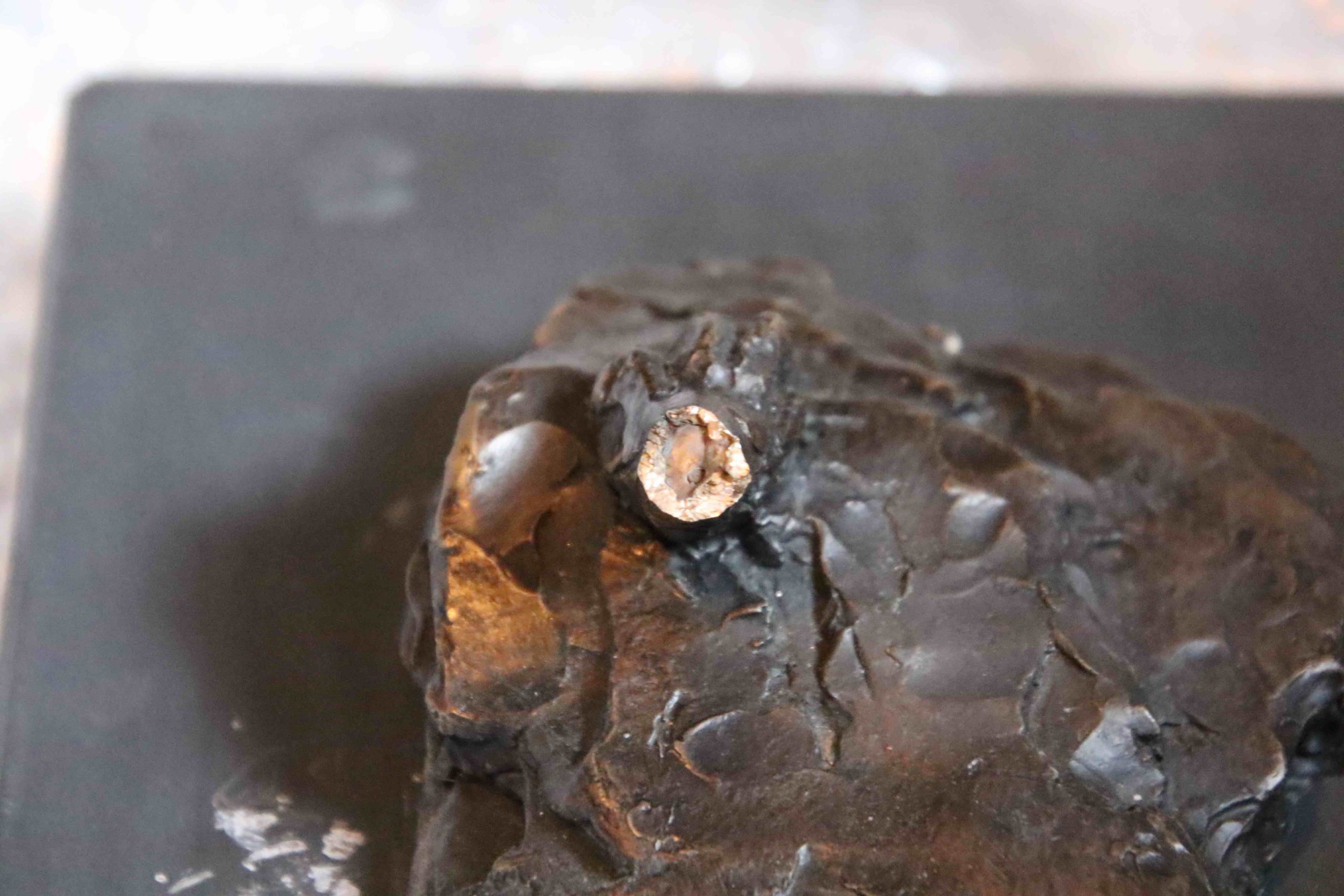
(Above) A thin part of a Foundry Bronze metal statue has snapped – close examination shows this is a welding point. A hidden defect is revealed by the little cavity where the weld was too thin. Hidden defects in Bronze metal almost never cause issues as it is so tough.
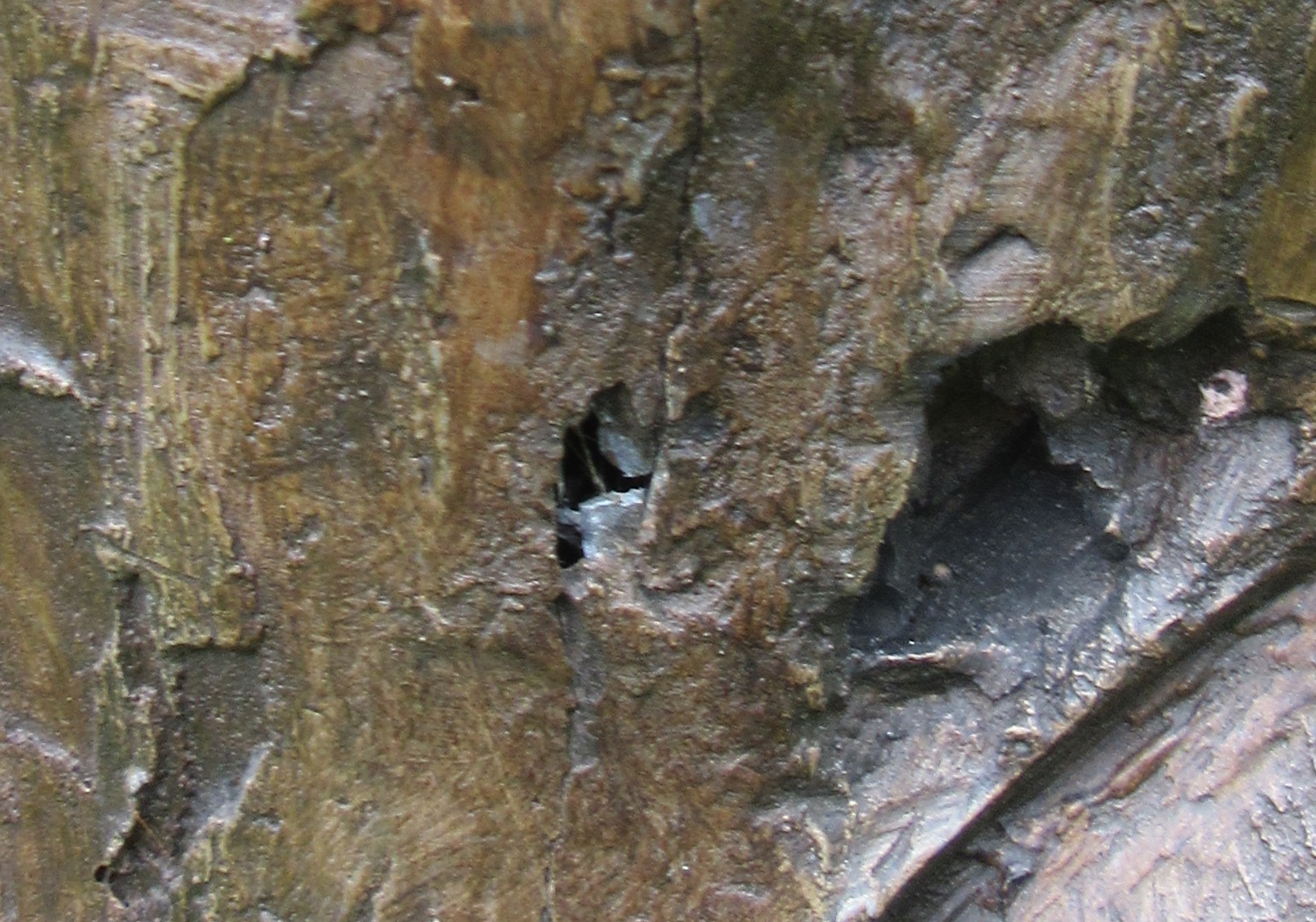
(Above) you can see a small crack in a Bronze Resin statue, along with a small chip which we have zoomed the camera in close on. Superficial damage is repairable at home with the right advice, but on a new statue it may be best to ask for a replacement.
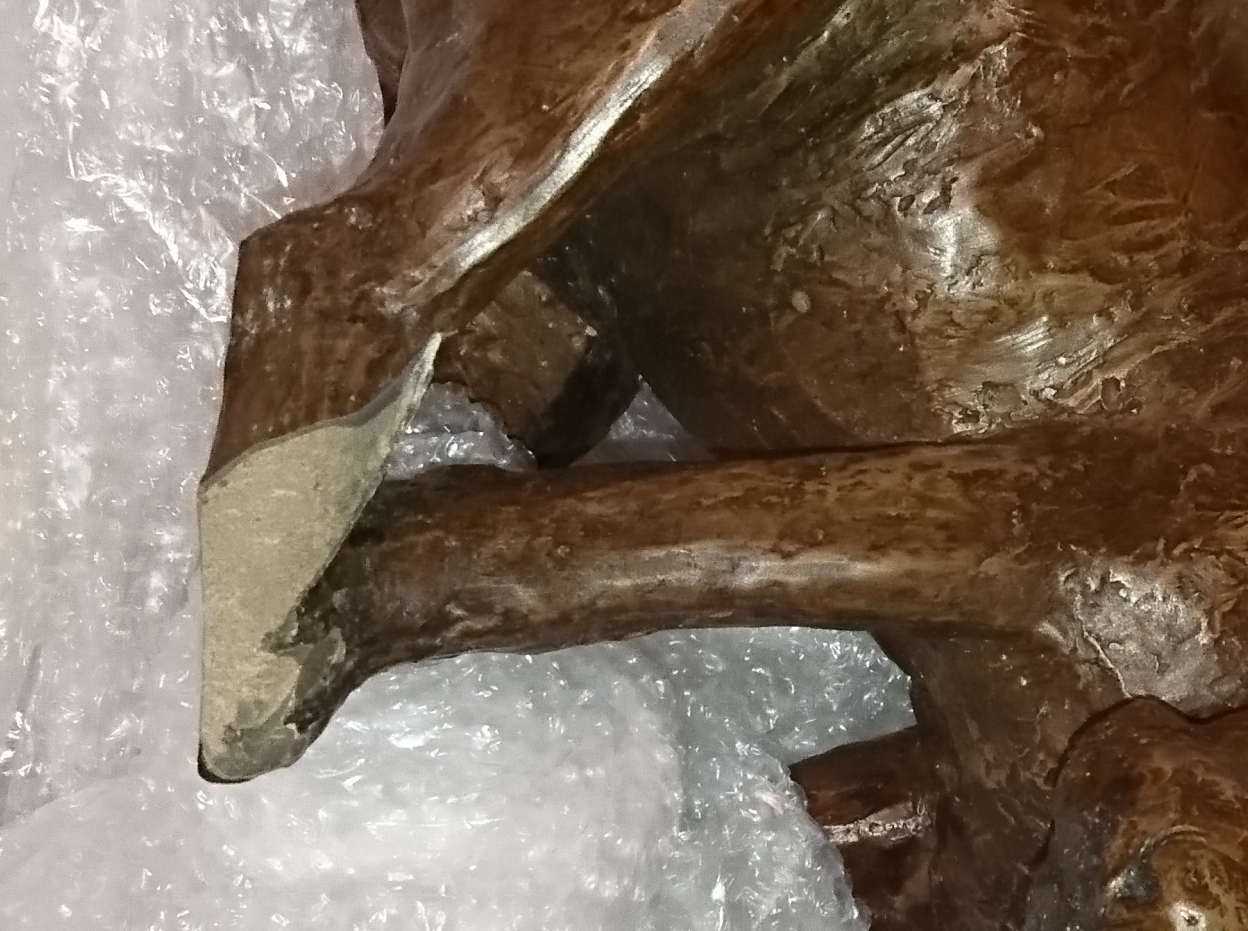
(Above) significant damage caused to a Bronze Resin statue in transportation should be sorted out by the sculptor. Take plenty of photos and see if you can find, bag up and label the pieces if you can find them, in case they are needed.
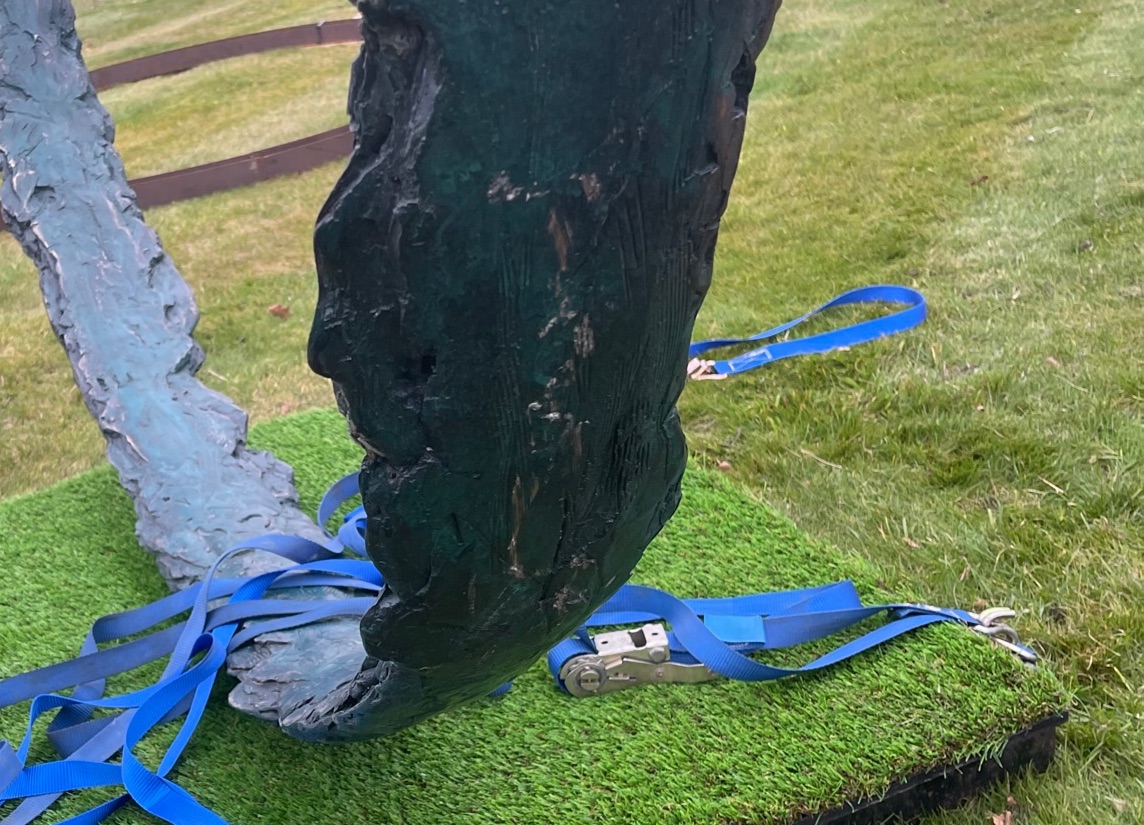
(Above) This Foundry Bronze metal statue was accidentally tipped down some stairs by a gardener. A long scratch has removed the patina (colour) of the surface bronze, showing the gold colour bronze beneath. See below)
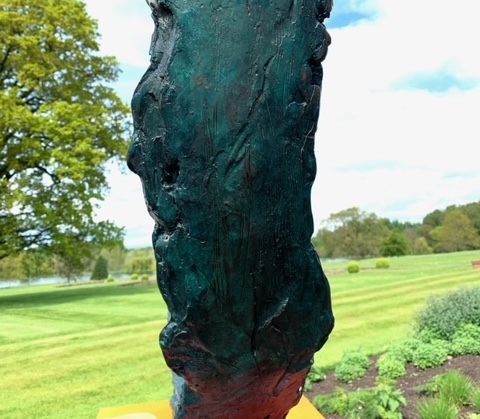

Follow The Artist
Keep up to date with Tanya's latest work!